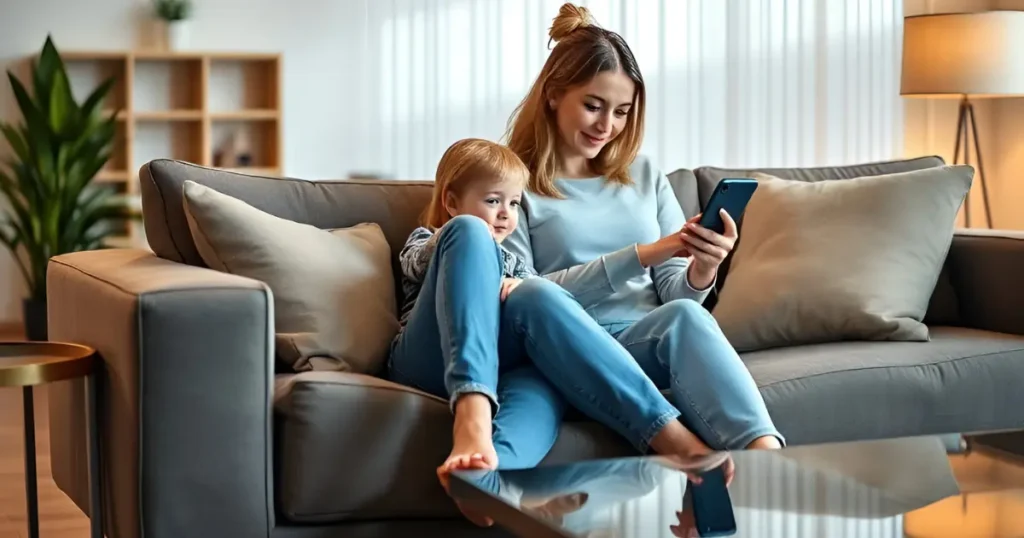
Introduction
In the era of constant connectivity, are we losing touch with meaningful communication?
The average American spends over 7 hours a day glued to screens (Forbes). Technology keeps us connected to the outside world, but it also controls how we communicate with each other, which often leads to bad outcomes. Therefore, we will discuss the 10 negative effects of technology in communication, a topic that resonates deeply with many of us.
Technology is transforming how we connect—and not necessarily for the better. Healthy communication is not just about words; it also involves relationships, mental well-being, and genuine human connection. So, are we really letting technology run things? Please stay with me, and I will demonstrate how to rid yourself of this tech overload!
Are you ready to find out? Let’s go! 🚀
What Is Tech Overload, and How Does It Affect Communication?

Ever feel like your brain’s buffering because of too much screen time? It’s called tech overload when you feel too busy to use your digital gadgets. Like juggling alerts, emails, and endless scrolling at the same time, there’s no time for real relationships. What was the effect? Someone has a communication breakdown that is hard to ignore.
You may want to read: How to Be Emotionally Available for Your Child: Love in Action
In fact, over 75% of Americans admit that technology negatively affects their ability to connect with others (Pew Research Center). Because we spend so much time in front of screens, we lose important social skills, such as reading nonverbal cues and maintaining emotional intelligence.
The rise of digital dependency means we’re more comfortable texting than talking, even with loved ones. What’s the joke? Tech should bring us together, but it makes us farther apart.
As Digital Wellness Expert John Doe wisely says, “Technology should serve communication, not replace it.”
Is it time for a digital detox? You decide.
You may want to read: How to Be Emotionally Strong in a Relationship: Heartstrong Love
10 Negative Effects of Technology in Communication

1. Decreased Face-to-Face Interaction
Have you ever tried to figure out how someone feels by reading their text? You could play charades with your eyes closed! Face-to-face interaction has become much less common in our digital world. Nonverbal signals, such as tone of voice, body language, and eye contact, are very important in relationships, but they are lost when people talk to each other digitally.
You may want to read: Unlock 10 Tips on Maintaining Good Social Relationship with Others
While Zoom calls are effective for remote work, they don’t foster the same level of trust and camaraderie as in-person meetings. Harvard Business Review recently broadcasted a case study showing that teams that only used digital communication had more misunderstandings and less work done than teams that met in person.
When we trade real-life interactions for emojis and GIFs, we risk weakening bonds that make our relationships meaningful.
You may want to read: How to Fix a Toxic Relationship With Your Partner: Heal and Thrive
2. Communication Breakdown and Misunderstandings
Texting is quick and easy, but it’s also the best way for communication to break down. Messages are easy to misunderstand when they don’t have a tone or context, which can cause pointless arguments. How many times have you read “K” and wondered, “Are they mad at me?”
Privacy issues in tech-based communication make things even worse. Hacked messages, data leaks, and private conversations sent to the wrong people by mistake can all destroy trust. A 2023 report by Norton revealed that over 40% of internet users have encountered some form of data breach, raising concerns about how safe our digital conversations really are.
If healthy communication is the goal, it’s clear that relying solely on tech isn’t the answer. Sometimes, a simple face-to-face chat can solve what a thousand texts can’t.
You may want to read: 10 Ways to Help Your Parents: Reignite Love and Care
3. Social Isolation and Loneliness
Who knew that being “connected” could make us feel so… disconnected? “More screen time” has been directly linked to more people feeling lonely. A Cigna study found that 61% of Americans felt lonely, with heavy social media users being the most affected.
Social media, for all its perks, often fosters unrealistic comparisons. Even when you’re with other people, scrolling through perfectly managed feeds can make you feel bad about yourself or left out. It makes sense that digital contacts often take the place of real ones, leaving a hole that a comment or “like” can’t fill.
The more time we spend glued to our screens, the more we drift away from real-world interactions, leading to a tech-induced sense of isolation.
You may want to read: Exploring Child Rages Only at Home: From Love to Fury

4. Erosion of Emotional Intelligence
Have you ever felt someone was “cold” in their texts? Blame the tech! Over time, using screens to talk to each other can make it harder to learn “empathy and regulate emotions—core elements of emotional intelligence.”
You may want to read: Coffee And Healthy Relationships: Love In A Cup!
It’s harder to connect on a deeper level when we can’t see or hear how much our words mean. Couples who send short, emotionless messages often have relationship problems because they can’t easily understand each other.
Studies show that individuals heavily dependent on digital communication are less skilled at reading facial expressions or detecting emotional tones in conversation, which can have a ripple effect on personal and professional relationships.
You may want to read: How to Change Your Mindset Overnight: Transform Your Love Life
5. Overreliance on Digital Devices
Raise your hand if you’ve ever looked at your phone while talking to someone! According to Asurion, the average person glances at their phone 96 times a day, indicating that smartphone addiction is negatively impacting real-world communication.
People who use their phones too much often use “phubbing,” which means avoiding someone to use your phone, which can hurt relationships and make people feel undervalued. When our phones or tablets take over, talks lose their depth, and interactions are, at best, flat.
While technology makes life convenient, it’s worth asking whether we are sacrificing genuine human connection for instant digital gratification.
You may want to read: When Someone Is Always Angry: How to Respond
6. Tech-Induced Stress and Anxiety
Have you ever felt a mini-panic attack when you couldn’t find your phone? That’s “nomophobia,” which means being afraid of being without your computer. Nomophobia is becoming a bigger problem. A study in Psychiatry Research says that over 70% of smartphone users experience some level of nomophobia.
But it doesn’t stop there. Digital fatigue happens when we get too many alerts, emails, and texts all at once. This makes us mentally tired and anxious. Living in a constant state of “on-call” stress can make it hard to enjoy the present, which can hurt our mental health and relationships.
“Technology can either enhance your life or overwhelm it—it’s up to you to set the boundaries.” – Digital Wellness Expert.
You may want to read: 5 Ways to Improve the Quality of Your Relationship With Others

7. Decreased Attention Span
Ever feel like your attention is scattered, like confetti in the wind? Tech is to blame! A Microsoft study found that people can only pay attention for an average of 8 seconds. Our brains are set up to want things right away, so we switch between apps, notifications, and tabs all the time. This makes it hard to focus on important conversations or chores.
This lack of focus seeps into our relationships, where deep, meaningful conversations are replaced with half-hearted exchanges. Our focus shifts to the next digital distraction, leading to the neglect of deep learning and active listening, which are essential for emotional connections.
You may want to read: How to Deal with Irrational Elderly Parents: 8 Practical Tips
8. Cyberbullying and Online Harassment
The rise of digital communication has unfortunately paved the way for cyberbullying and online harassment. Because they can stay anonymous on the internet, many people feel free to cross boundaries. This includes making cruel comments on social media or sending threatening messages.
Pew Research Center says that 41% of adults have experienced some form of online harassment, and teens are even more vulnerable. The mental health effects—like anxiety, depression, and social withdrawal—are devastating, especially for young people trying to navigate the online world.
The convenience of digital platforms shouldn’t come at the cost of kindness and respect. It’s a sobering reminder that while technology connects us, it can also become a tool for harm.
You may want to read: My Female Coworker Is Obsessed With Me: Take Control Now
9. Phubbing and Its Impact on Relationships
Have you ever caught yourself ignoring someone right in front of you because you were glued to your phone? That’s phubbing—a blend of phone and snubbing. This kind of behavior is way too common in relationships today. A study in Frontiers in Psychology found that nearly 46% of people reported feeling ignored by their partner due to excessive phone use.
Phubbing hurts partners’ feelings and undermines trust and intimacy, making them feel unimportant. Attempting to have a heart-to-heart conversation while constantly competing with Instagram or TikTok for attention would be a terrible experience. This small habit can turn into relationship dissatisfaction, which can lead to bigger problems like anger or emotional isolation.
“Your presence is the greatest gift you can give someone—don’t let a screen steal it away.” – Relationship Coach.
10. Digital Interference in Family Communication
Remember the last time a family dinner turned into everyone scrolling on their phones? “That’s digital interference in action. Technology has crept into private family areas, turning real moments of connection into awkward silences or half-hearted nods.
A study by Common Sense Media revealed that 48% of families feel technology disrupts their quality time together. Family members often hide away in their computers or phones instead of sharing stories or laughing together. Over time, this lack of contact can weaken family ties, making people feel alone even when they are with their loved ones.
To combat this, try implementing a digital detox during meals or setting screen-free hours at home. These small steps can help you talk to the people you care about again in a healthy way and make memories that will last a lifetime.
Solutions to Overcome Tech-Induced Communication Issues

Embrace Digital Detox Practices
Feeling overwhelmed by constant screen time? A digital detox might be in order. Taking regular breaks from technology can reduce stress, improve mental clarity, and enhance relationships. Nielsen found that Americans spend 10+ hours daily on screens—imagine the benefits of reclaiming even a portion of that time!” for the most part.
Success stories from real life support this. For example, people who took Cal Newport’s Digital Declutter Challenge said they had stronger relationships with their loved ones, slept better, and got more done. Hiking on the weekends, board game nights, or even a traditional family dinner without phones or tablets can bring everyone closer together.
Focus on Emotional Intelligence Development
Setting up emotional intelligence (EQ) is key to repairing tech-damaged communication. Empathy and emotional regulation in daily life can really help. As a first step, put down the phone and pay attention to what other people are saying.
Emotional intelligence training programs, like those given by the Institute for Social and Emotional Intelligence, might be a good idea. These programs give you useful ways to become more self-aware, empathetic, and good at resolving conflicts. All of these things are important for having better interactions.
Promote Healthy Communication Habits
Want to strengthen your ties? The first step is to develop healthy communication habits. Learning to be good at active listening, conflict resolution, and face-to-face interaction can help people form bonds that matter again.
Take a step back, listen without interrupting, and reply thoughtfully when you disagree with someone. Simple things like making eye contact during talks can help people feel closer to each other.
As noted by Dr. Sherry Turkle, “The best way to reconnect is to disconnect from technology.”
By prioritizing quality interactions and setting limits on technology, you can restore balance and care for the relationships that matter most.
Frequently Asked Questions
What are the signs of tech overload?
You might not even be aware that you have too much tech. Some of the symptoms are stress, decreased attention span, and social isolation. As an example, digital dependency could be the cause of your anxiety when you can’t check your phone or your stress level when you get too many alerts. You might also want to think about how much screen time is affecting your relationships and mental health if you notice that you’re pulling away from people in real life.
Can digital improve relationships?
Of course! A digital detox can help your relationships in big ways. Genuine connections can happen when you unplug. Picture a weekend without your phone. There would be no distractions, no endless scrolling, and you and your loved ones would have quality time together. Many people who do a digital detox say they can communicate better, have more empathy, and feel emotionally connected. It’s all about being with each other and away from computers all the time.
How can I maintain healthy communication in a tech-savvy world?
Today’s tech-driven world makes it important to balance digital and real-world contacts in order to keep communication healthy. Set up tech-free zones to begin, like during family meals or date nights. Active listening, which means giving the person your full attention instead of doing something else or checking your phone, can help you communicate better. Also, don’t forget to put face-to-face interactions first as much as possible. These simple but useful steps can help you make sure that technology helps your relationships instead of hurting them.
Conclusion
In this digital age, we’ve explored the 10 negative effects of technology in communication—from decreased face-to-face interactions and communication breakdowns to the rise of social isolation and tech-induced stress. It’s clear that technology makes life easier, but it also causes problems that affect our mental health, relationships, and ability to talk to each other.
The key takeaway? It is very important to balance technology use with real-life connections. Smartphones, social networks, and instant messaging can help us stay in touch, but they should never replace real-life conversations.
As you move forward, try to embrace healthier communication habits—whether it’s active listening, setting tech-free zones, or engaging in a digital detox. By being aware of how technology changes the way we talk to each other, we can ensure that technology improves our relationships and well-being instead of hurting them.